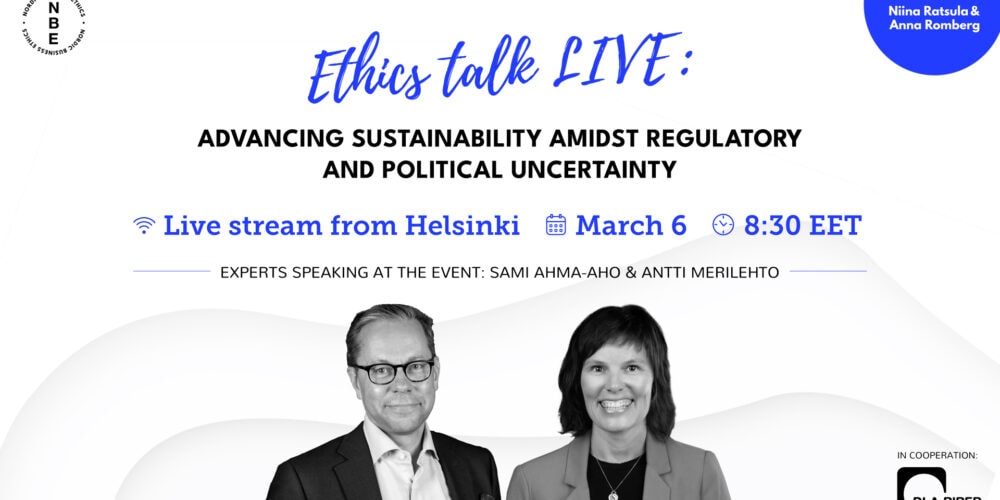Similarities and differences between anti-corruption work and human rights
Author: Heidi Platou, Head Advisor Human Rights (former VP Head of Compliance), Statkraft AS
This blog post was inspired by the EthicsTalk LIVE on December 9th, where Heidi was a panelist. If you want to read more about the event and the amazing panelists, head over to the event page. They key points of the panel were summarized into this blog post and the recording of the event can be watched on YouTube.
The beginning of formalization
A decade has passed since the adoption of the UN Guiding Principles (UNGP) on Business and Human Rights, and with it the concept of business’ responsibility to respect human rights was formalized. However, in many ways the concept is just now getting some more traction. Just like anti-corruption programs, business ethics and Compliance entered the business world with a force a decade ago in Europe, human rights are now the new kid on the block. In my view we are currently in a paradigm shift in how businesses take up and embrace their responsibility to respect human rights and embrace the three-pillar approach described by the UNGP. In 2022 the expectation is no longer only on ‘do no harm’, but to create shared value. It is about finding that space of opportunity and create positive impact. The businesses that will remain only focused on the law and finding ways to avoid legal liability, will be left behind. That is my prediction at the start of the new year and the eleventh year of the UNGP.
the similarities and the differences
There are some clear big-picture similarities between an anti-corruption approach and human rights. Firstly, it is easy for companies to only deal with the need for a dedicated approach if and when a problem has occurred. Many elaborate Compliance programs have arisen from the ashes of a global corruption scandal hitting the company. I believe the same is the case for human rights; those companies that have seen the negative effects on a company’s operations, financials and reputation by causing or being involved in major human rights violations, learn from their mistakes. Still, all companies may also learn from these examples and take a proactive and preventative approach to managing both of these topics as key non-financial risks.
However, one key difference between anti-corruption work and human rights is how the company should assess the risks. Within the Compliance community the risk assessment has typically dealt with how corruption represents a risk to the company, as a legal, financial and reputational risk. This risk can be quantified with some practice, although it is not necessarily an easy exercise. Human rights violations may also to some extent be quantified and qualified as legal, financial and reputational risks, but the starting point for a human rights impact assessment is how the company impacts the rights-holders, i.e. the people who’s individual, fundamental human rights may get impacted by the companies’ activities or business partners (like you do when assessing health and safety risks, which of course at the core is also about human rights). Reviewing these two dimensions in parallel, namely risks to people and risks to the company, is a demanding exercise for companies to undertake. It requires sufficient competence in the underlying human rights, the methodology described in UNGP and similar frameworks, and not least a deep understanding of the different aspects of the business, its activities and the supply chain.
Quick wins
This leads me to the more operational aspects of building a Compliance and human rights program within the company. Because of the similar aspects between the two approaches, there are some quick wins available by connecting human rights to specific parts of an already existing Compliance program. For instance, by including human rights impacts and adverse media information about potential suppliers, customers and other business partners and integrity due diligence procedures. Another example is including labour rights of internal stakeholders as part of your corruption risk assessment process as you are anyway speaking to employees at different levels of the organization. If you have a training and awareness program on corruption, and who doesn’t today, a quick, high level evaluation of key target groups to add a module on human rights, the company approach and key aspects of how human rights are relevant in the day-to-day activities, is another quick win to improve awareness. This approach could be taken for all parts of the existing Compliance program by hooking human rights onto and into existing processes where possible and where it makes sense dependent on your core business processes and activities.
One key aspect which is important to not lose sight of while you search for ways to build human rights into existing preventative approaches and create synergy effects, is the need for constructive and meaningful stakeholder dialogue and engagement within your human rights program. Stakeholder dialogue requires companies to not only undertake qualified analysis to identify who these stakeholders are from a human rights perspective, but to create a strategic approach to how to allow for dialogue and communication with people of different culture, background, language skills, understanding of time, and different world and spiritual belief than the business.
fuel to the fire
A big driver of compliance programs the world over has been corporate sanctions and the substantial increase in penalties and fine levels in combination with extraterritorial jurisdiction applied. A similar approach has not yet been seen within the human rights domain, where only a few cases of abuses and violations abroad has been allowed tried and tested in home jurisdictions of multinational companies. It will be interesting to see whether increasing adoption of domestic mandatory human rights due diligence legislation in Europe particularly, combined with traceability and transparency requirements will also result in more liability claims by those whose rights have been violated and put even more fuel to the fire in this paradigm shift we are experiencing to further companies’ respect for human rights. One thing is for sure, those who are not joining up, will be left behind.



